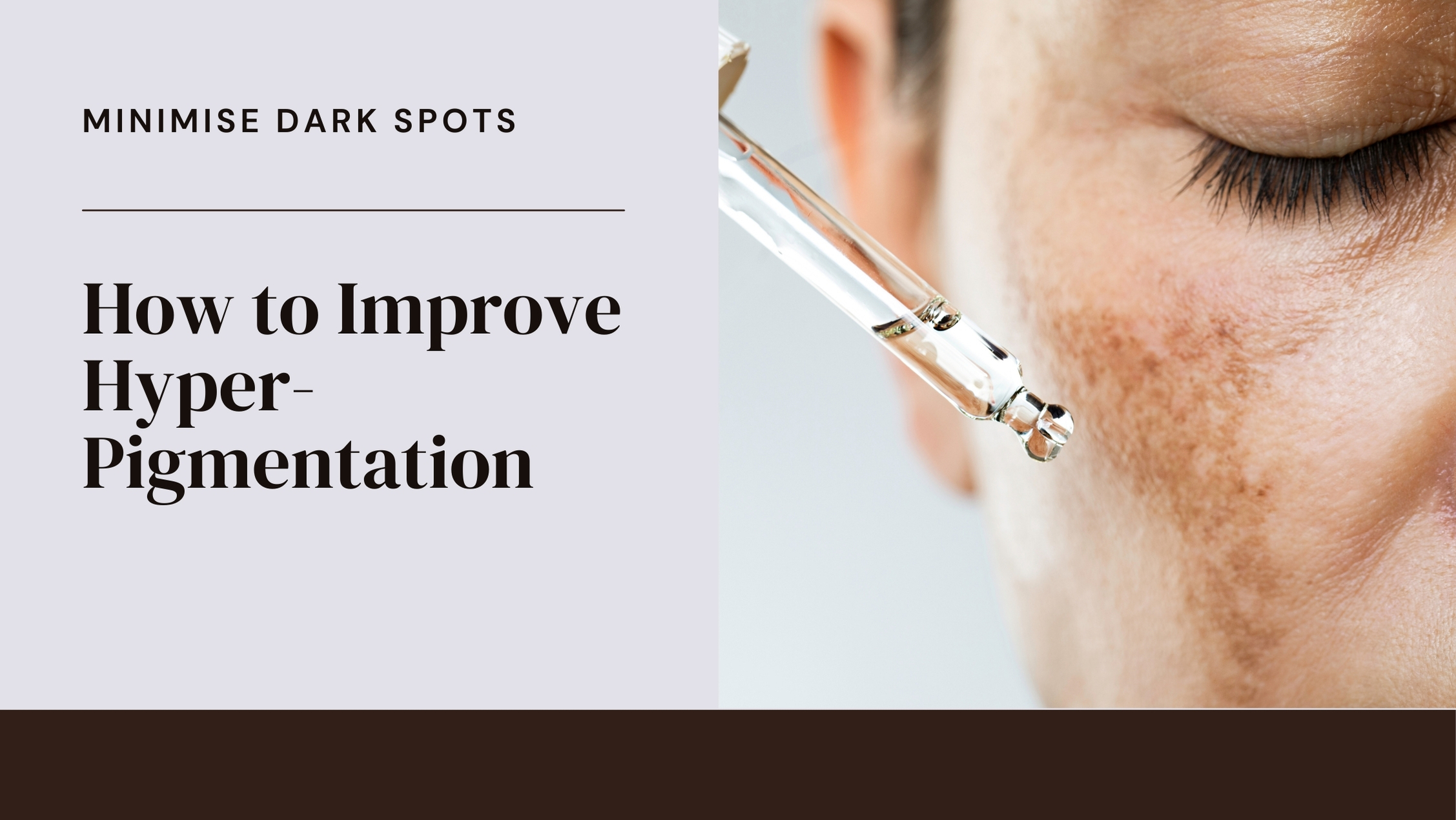Hyperpigmentation is when patches of your skin become darker due to extra melanin deposits. This can cause brown spots, sun spots, melasma, and uneven skin tone. It’s a common issue that’s tough to treat. Hyperpigmentation can be caused by sun exposure, hormonal changes, inflammation, age, skin injuries and acne.
Melanin is produced, packaged and delivered to the upper layers of the skin, resulting in visible pigmentation. Once melanin has been deposited in the skin it remains until the skin has turned over and been replaced naturally. This is why most products that claim to treat hyperpigmentation don’t have an immediate effect. Instead, they need to be used for an extended period while the melanin in the skin is turned over. A full routine should include minimising melanin generation/transport, increasing skin turn-over and exfoliating dead skin cells in dark spots.
Minimise Melanin Generation and Transport
You can minimise melanin generation and transport by:
- Using sun screen to protect the skin from UV rays and prevent the trigger of melanin generation.
- When used in conjunction with sunscreen, using Vitamin C can enhance the skin’s defence against UV rays, further preventing the formation of dark spots and hyperpigmentation.
- Using Niacinamide which targets the melanin transport step preventing it from being deposited in your skin.
- Using products containing ingredients that disrupt the melanin generation processes (see section below).
Increase Skin Turn-Over
Our skin cells turn over naturally with new cells replacing old cells from below. The rate that they turn over decreases as we age. Maintaining your skin health and a healthy lifestyle through exercise, a balanced diet and drinking plenty of water can help ensure that it is turning over at the highest natural rate.
It is possible to increase skin cell turn-over through the use of chemical compounds such as Retinol (a type of Retinoid). Retinol can be harmful if not used correctly which is why it requires a prescription in New Zealand. Only use Retinol if you have been prescribed to by your doctor.
Exfoliate
As our skin cells turn over the dead cells sit on top of the newer cells and can cause the skin to appear dry and flaky. The build-up of dead-cells has many negative effects, but for Hyperpigmentation, the melanin deposits will remain within this layer of dead cells. That is why exfoliation with AHAs is important in helping to reduce the appearance of dark spots. Take care not to over exfoliate as this could cause damage to the skin barrier which has various negative effects.
Ingredients Inhibiting Melanin Generation
With these ingredients there is often a trade-off between concentration and risk of irritation. We will list the target concentrations we have found that are a balance of effectiveness and irritation.
Natural Extracts
Licorice Root, Uva Ursa (bearberry) and Peony extracts contain the isolated ingredients listed below (Arbutin, etc). The challenge with natural extracts is that we don’t know the concentration of isolated ingredients so we cannot be 100% sure of their effectiveness. The strength will vary between suppliers and production runs. If you have light pigmentation and want to take a more natural and lighter approach then Natural Extracts may work for you.
Arbutin
Arbutin is similar to Hydroquinone though it is not as strong or irritating to the skin.
Target strength: 2%
Tranexamic Acid
Tranexamic Acid moderately inhibits melanin production and is generally safe and well tolerated. It is often prescribed orally for treatment of Melasma and topical applications are showing promise in studies.
Target Strength: 3%
Azelaic Acid
Moderately effective at slowing melanin production and is fairly well tolerated. It can also help with acne.
Target Strength: 10-20%
Kojic Acid
Good for lightening skin but may cause irritation and redness, especially in sensitive skin. Compound is fairly unstable and should be thrown out if it changes from white to brown to black.
Target Strength: 1-2%
L-Ascorbic Acid
L-Ascorbic Acid is the most potent form of Vitamin C that provides brightening, boosts collagen production, and offers antioxidant protection. This form of Vitamin C can be more irritating and less stable than others. People with sensitive skin may start with lower concentration to avoid irritation. Higher than 20% is very likely to irritate your skin.
Target Strength: 20% (lower if skin is irritated)
Ascorbyl Glucoside
Ascorbyl Glucoside is a stable, gentle, and gradual form of Vitamin C that can be used as an alternative to L-Ascorbic Acid.
Target Strength: 2-5%
Hydroquinone
Hydroquinone is very effective at treating dark spots. However, it can have negative side effects including irritation and halos (ring of lighter skin around spot). Extended use may also result in complete loss of pigmentation or darkened skin. Hydroquinone requires a prescription in New Zealand. Treat only the areas of hyperpigmentation and stop treatment for 5 months once your skin has shown some improvement or has shown no improvement after 3 months.
Target Strength: 2-4%
Conclusion
Treating and preventing Hyperpigmentation can take time and requires ongoing prevention. We need to prevent melanin generation and encourage the turnover of cells containing melanin. Given that skin cell turnover takes 14-20 days as teenagers, approximately 30 days from 30-40 years old and 60+ days in our 60s we can expect that any treatment will require a long term approach. The best approach is to try and avoid dark spots in the first place through consistent sunscreen use.


0 Comments